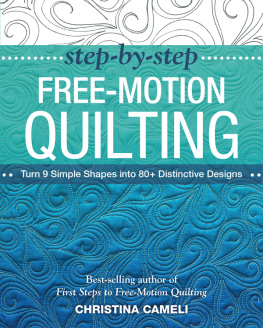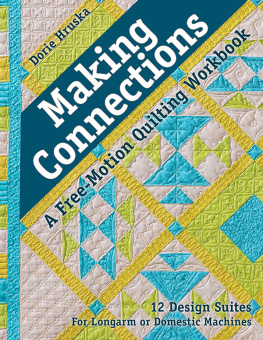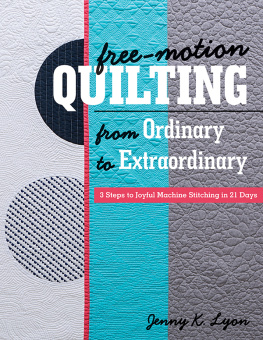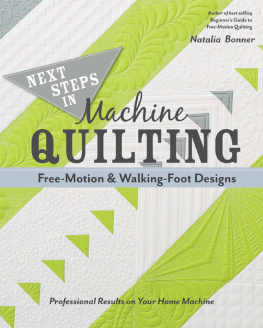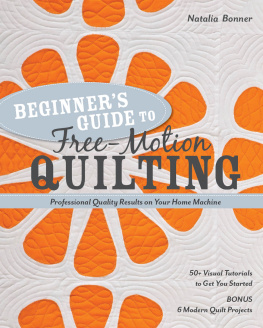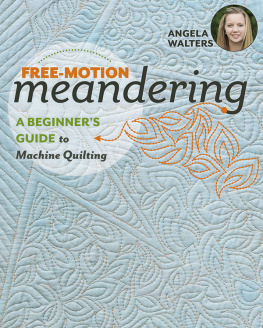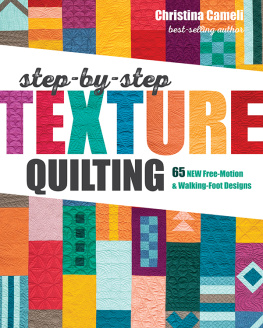
Dedication
For Mary Ann Cameli


Acknowledgments
I can attest that a book appears only through much nurturing of the author. I have profound gratitude to so many people: to my family, for raising me as an artist and loving me as I am; to my friends, for sharing my joy; to my teachers, for passing on their wisdom; to my students, for choosing to grow; to my readers, for convincing me I had something to share; to my publisher and editors, for taking a chance with such enthusiasm; and most of all, to Charlton and Ellery, for more patience and love than I could imagine. Thank you all, from the bottom of my heart, for helping me share what needed to be shared.
Introduction
Do you feel a thrill at running your hand over stitching, or catch your breath at a beautiful design created with thread? If you delight in the look and feel of free-form stitching but have wondered how to get started, I wrote this book for you.
I want to get you excited about free-motion quilting. I want you to feel the joy of starting, the pleasure of overcoming obstacles, and the contentment of loving what youve made. I want you to be giddy when you present your next quilt to its recipient.
The basics of free-motion quilting are not at all diff i cult. The supplies needed are minimal, and with them you can stitch an endless array of designs to personalize your creations. You are not limited to straight lines or gentle curves; with thread you can draw any design you can imagine.
As many quilters are aware, the thing that will make or break success with free-motion stitching is practice. And thats where some of us get stuck. Do we risk practicing on a beautiful quilt top? Do we just stitch aimlessly on some scraps of fabric?
This book offers a different approach. I bet you sew because you love fabric and you love making beautiful things with it. So lets do thatmake something beautiful while practicing free-motion stitching. Learn the basics, gather the supplies, and then pick a project and start stitching. The projects are designed to be light on assembly so you can spend most of your time actually stitching, improving your free-motion quilting skills.
Im ready to help you over the little hiccups that keep people from free-motion quilting. If youre not sure what design to stitch on your next quilt, Ive included a chapter of designs. If problems pop up, theres a troubleshooting guide.
This book wont turn you into an expert quilter; Im not an expert quilter either. But you and I can still make beautiful things with needle and thread. Its simply a matter of jumping in with joy and getting better as you go. I love to share the magic of stitching this way.
Whether youve just discovered free-motion quilting or have wanted to try it for years, this book is your bridge, from wondering to knowing, from hesitating to acting. Youre ready. Take a deep breath, get in there, and amaze yourself.

The Necessities
The good news is you probably already have most of the items you need for free-motion quilting: a machine, needles, and thread. Just gather a few more supplies and youll be on your way!
YOU NEED A DARNING FOOT
Unlike other sewing youve done, free-motion quilting relies on you to move the fabric in the direction you want it to go, instead of having the machine do so. To allow free movement of your work, you need a darning foot, sometimes called a free-motion foot. This special sewing machine foot lets you move fabric in any direction between stitches, but keeps the fabric against the stitch plate when the needle is down to allow the stitch to form properly. Plastic or metal, square or round, closed or open, they all do the same job. Any darning foot that fits your machine should work. If you have more than one darning foot to choose from, choose the one that offers you better visibility. In other words, an open toe rather than a closed toe, offset shank versus inline, thinner versus thicker. Your local sewing machine dealer can help you find a darning foot that will fit your machine.

Variety of darning feet
YOU NEED A CLEAN MACHINE
During sewing, and particularly quilting, lint from the thread, the fabrics, and the batting will accumulate around the foot and under the stitch plate. Lint buildup can interfere with the action of the thread enough to cause thread breakage or skipped stitches. If youve never cleaned out your machine before, now is the time to learn.
Cleaning a sewing machine
Remove the bobbin and clean out the inside of the bobbin case. Lint in the corners of the bobbin case and housing can cause problems. Give a quick wipe to this area with every bobbin change.

Remove bobbin to clean out bobbin case and housing.
Next, remove the stitch plate (if it can be removed), using the owners manual to guide you. This is usually done by releasing a lever or loosening screws. Use a soft brush or a scrap of batting to wipe away any clumps of lint accumulating around the feed dogs and bobbin housing. Do this full, plate-off cleanout every three or four bobbin changes. Oil the machine regularly as recommended in the owners manual.

Stitch plate removed for cleaning
TIP
Cut batting scraps into 2" squares to use for lint cleanup.
Is your machine big enough?
Even though it can be tight, you can quilt bed-sized quilts on a regular home machine. Remember that you will only have to fit enough of the quilt under the sewing machines arm to reach to the middle of the quilt (you can quilt the other half from the other side). So if you have a quilt 88" 100", you only have to get 44" under the arm of the machine to be able to reach every area of the quilt for quilting. This is possible even on smaller home machines.
YOU NEED THE MACHINES EXTENSION TABLE
Many sewing machines have a free arm for detail sewing and a larger extension table that fits around the free arm. Trying to quilt on a skinny free arm is an exercise in frustration. If your machine doesnt have an extension table, try this test: Place your hands as shown in the picture below. If your palms and fingers are not supported, youll need to put a table around the machine bed.

Palms and fingers are supported.
If you need an extension table, you can order a custom Plexiglas extension table through your local sewing machine store. Alternatively, you can purchase a sewing table that a machine lowers into, so that the tabletop lies flush with the surface of the sewing machine. This creates a continuous fat surface and reduces the effort necessary to move the quilt top as you stitch.
Next page

